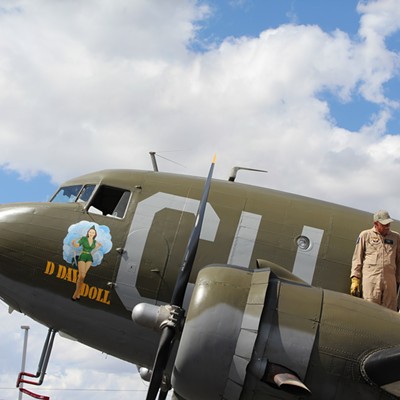The women followed him to the lecture room where Lyle McNeal, a Utah State University professor, was explaining how he had discovered the lost breed. "If I could have some of those sheep," said Begay, "I could go happily to the next life."
At 102 today, Goldtooth Begay has not yet gone to the next life. But his family now has a flock of 50 churros and 20 goats on the land they occupy in the Navajo reservation in Keams Canyon, Arizona. His daughters, Alta, 40, and Sharon, 45, spearheaded the effort to reintroduce churros to the Navajos as an effort to combat the dysfunctionalism that has plagued the nation.
And not a moment too soon. The quarter-million Navajos on the reservation occupying 16 million acres (not counting the surrounded Hopi reservation) in Arizona, New Mexico, Utah and Colorado are a battered people who need a lift. Although alcoholism, spousal abuse and unemployment are never mentioned in Tony Hillerman's novels, they are epidemic.
The Navajos and Apaches, both part of an Athabascan-speaking group, migrated to the Southwest from Canada between AD 900 and 1200 and were well-established by the time the Spanish arrived. In 1540, conquistador Francisco Vasquez de Coronado brought to the region an ancient Iberian breed of sheep called churra (later corrupted to churro), prized for remarkable hardiness, adaptability and fecundity. Later, in 1598, Juan de Onate brought 5,000 more churros. The Navajos raided Spanish camps and appropriated flocks of churros for themselves, and the Hopis taught them how to build looms and make fabrics.
In the 19th century, the United States displaced the Spanish and sent troops into the Southwest. During a festival, the Americans killed more than a dozen Navajos when the latter discovered them cheating to win a horse race. On June 15, 1863, Brigadier General George Carleton ordered Colonel Kit Carson to subjugate or exterminate the Navajos. Historians believe Carson was disinclined to make war on the tribe. Yet he ruined them with a scorched-earth policy, destroying their ability to live through the winter.
The Navajos surrendered the following January and were marched to Bosque Redondo in southeastern New Mexico. More than 9,000 were interned there from February 1864 to March 1865. The experience has been compared to the Bataan Death March and Nazi concentration camps.
After pressure from a small group of whites, Carleton was removed and, finally, in June, 1868, a military escort led 7,000 Navajos back to a part of their homeland under terms of a new treaty.
The Long Walk and its consequences were so devastating that the Navajos have never fully recovered. Most of their 2 million sheep were lost during the Long Walk. They were then issued about 14,000 sheep and 1,000 goats in small family lots and encouraged to breed more, but overgrazing and erosion nearly destroyed the land. By 1933, erosion was so critical the Roosevelt administration urged Navajos to drastically reduce their numbers of horses and sheep. The government introduced what it called "better breeds" (merinos, Shropshires and Rambouillets) and slaughtered churros. Some of the churros were hidden in the canyons of the reservation and managed to survive, but the churro sheep culture that had become a Navajo tradition was ravaged.
IT WASN'T UNTIL NEARLY the end of the 20th century that churros were rediscovered. In 1977, Lyle McNeal of the Department of Animal, Dairy and Veterinary Science at Utah State University in Logan found some churro at a shearing school in Shiprock, N.M. McNeal set about establishing a gene pool. He acquired six ewes and two rams and began searching the reservation canyons for the descendants of the sheep the Navajo had released before the Long Walk in 1863.
When the Begays met McNeal in 1978, the Navajo-Churro Sheep Project was born. Today, the breed is flourishing with more than 1,000 in the registry and gaining in popularity, though it is still considered a rare breed.
Sharon Begay saw McNeal as a kind of savior of her family. "We've been friends with Dr. McNeil ever since," she said. "We adopted him into our family and told him if he wants to live on our land, we would build him a hogan."
The Begays pooled their money and bought seven ewes and a ram. The oldest sister, Lena Begay Benally, agreed to live with her parents and manage the flock. As they had hoped, the churro project unified the family. More than that, Sharon's only brother has overcome his problem with alcohol to join in the flock's management.
"By the '90s, our flock grew up to 150 ewes," said Sharon, but the family was concerned about overgrazing and began to share the churros with other Navajos, hoping the project would rejuvenate other families.
"People came and brought Rambouillets and merinos to exchange for churros," Sharon said. "We sold the merinos and Rambouillets to Hopis to use in their ceremonies."
Because the churro fleece is long, lustrous, silky and durable, and comes in a variety of natural colors, it is highly prized and the Begays can sell it for 90 cents a pound, instead of the 6 cents paid for the wool of other sheep. They market some of it to Anglo traders, but sell most of it to individual weavers on and off the reservation. Lena makes felt from some of the wool and works it into Navajo designs. All the women in the family weave it into a variety of blankets and rugs.
Unfortunately, however, the impact of the churro program has been narrow. Only about 40 Navajo families have acquired churros. Meanwhile, alcoholism and spousal abuse continue. There are very few employment opportunities for men on the reservation. In the Navajo matriarchal tradition, most women work in cottage industries like weaving, potting and making jewelry. Men must go off the reservation to find work, although they also supply their homes' firewood and water and care for family livestock. Some find jobs for two or three weeks with occasional Chapter House programs.
But, according to Brother John Holstream of St. Anne's Catholic Mission in Klagetoh, "Close to 50 percent of them do little or nothing because of circumstances or addiction." Sharon believes that with the traditional warrior and horse cultures gone, Navajo men are adrift. They have difficulty working in cities off the reservation because of poor English and lack of education (high school drop-out rates are high). Lonely, she said, they turn to alcohol.
Will the reintroduction of a sheep culture save the Navajos? "The younger generation does not know about churros and a lot of them do not want to get into sheep," said Sharon. Her own son, Sean, said he wasn't interested in becoming a sheep herder. When he gets out of high school, he wants to leave the reservation and attend a school to learn auto mechanics.
But Sharon has hope. "To many Navajos, sheep are sheep," she said. "They don't understand the special quality of the churros. We are educating them."












